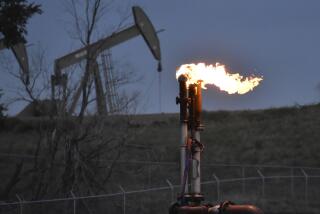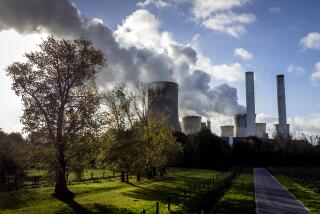Greenhouse gases climbing, federal report finds
Greenhouse gases are building at a steep rate in the atmosphere, the nation’s top climate agency reported, renewing concern that global warming may be accelerating.
The National Oceanic and Atmospheric Administration’s Annual Greenhouse Gas Index, which indexes the key gases known to trap heat in the Earth’s atmosphere, rose 1.5% from 2009 to 2010, the agency reported.
The reported rise comes on top of an analysis by the Energy Department last week saying that global emissions of carbon dioxide, a key, long-lived greenhouse gas, had jumped by the biggest increment on record in 2010. The figures showed a 6% increase from the year before, a steeper rise than worst-case scenarios that had been laid out by climate experts four years before.
The Annual Greenhouse Gas Index number, by contrast, looks small, but has big impact. The index is a measure of the combined heating effect of the top greenhouse gases during their life spans as the gases float around in the atmosphere. The number increased from 1.27 in 2009 to 1.29 in 2010. Since the index started in 1990, which the NOAA team chose as a baseline, the increase has been 29%.
“The way you have to look at these things is over time. So we’re up over 20% over where we were in 1990, in our effort to cut greenhouse gases. So we’re not doing very well,” said Jim Butler, director of the Global Monitoring Division of NOAA’s Earth System Research Laboratory in Boulder, Colo., which produces the Annual Greenhouse Gas Index.
Numbers on the index, Butler points out, do not correlate directly to degrees difference in temperature. But when it goes up, warming potential increases.
“The sum of all of those tells you how much we’re increasing the warming potential of the atmosphere,” Butler said. “The analogy I use is the electric blanket. The numbers on the electric blanket don’t correlate to specific temperatures. If you’re really comfortable with it set on 3, and then you gradually turn it up to 6 to get warmer, at first you don’t notice anything. But in a little while you will, and then you’re going to stop turning it up, but you’re going to continue to get hotter.”
NOAA measures the gases in the atmosphere that most directly affect global warming, which it can do, Butler said, “with extreme accuracy.” The top five gases — carbon dioxide, methane, nitrous oxide and two chlorofluorocarbons called CFC11 and CFC12 — are responsible for more than 95% of the warming effect. About 15 other gases make up the last 5%.
Carbon dioxide is the biggest contributor, the longest-lived and most abundant of the gases. CO2 levels rose to an average of 389 parts per million in 2010, compared with 386 ppm in 2009. Back in the 1880s, before the Industrial Revolution, the CO2 concentration in the atmosphere was about 280 ppm. Other gases are showing similar increases.
One bit of good news in the report: Concentrations of chlorofluorocarbons are dropping, albeit very slowly, largely because of a ban instituted in 1989 on ozone-depleting aerosol spray propellants.
The greenhouse gas index was created to better express the heat-trapping potential of a gas, called “radiative forcing,” which is measured in watts per square meter. “This looked like a good way of presenting much of what we do within our organization, so people can understand the real effects,” Butler said.
More to Read
Sign up for Essential California
The most important California stories and recommendations in your inbox every morning.
You may occasionally receive promotional content from the Los Angeles Times.










